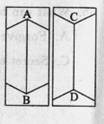题目内容
[1] Look at the center circles of Diagram A and Diagram B. Which of the centre circles looks larger? 
[2] Take a first look and you probably think that the centre circle in Diagram A is smaller than that in Diagram B. In fact, they are exactly the same size.
[3]Then look at the picture on the right. What do you see? A vase? Or two faces? Does the picture change quickly from one to the other again and again? Maybe or maybe not, but you can see them at the same time. 
[4]“What’s happening? Is something wrong with my eyes?” You may wonder at what you see. Don’t worry. Here is how it goes:
[5]When we look at things, our eyes send messages to our brains and then our brains interpret the information. However, sometimes our brains interpret the received information in a wrong way. It seems that our eyes are playing a joke on us. This often happens and we call it “Visual illusion(幻觉)”. 
[6] Movie makers often make use of illusions. They make the objects around actors much smaller or bigger than usual. This makes us believe that the actors are much larger or smaller than they usually are. The movies Jurassic Park and Honey J shrunk the kids just make use of illusions.
【小题1】In which column of a magazine can you read the above text?
| A.Culture. | B.Science. | C.Humour. | D.Education. |
| A.something is wrong with our eyes |
| B.the two circles are not of the same size |
| C.our brains interpret the information wrongly |
| D.pictures change quickly from one to the other |
A. The second one. B. The third one. C. The sixth one.. D. The fifth one
【小题4】What’s the right order according to the text?
a. We look at things with our eyes. b. Our brains interpret the messages.
c. Our brains tell us what we have seen. d. Our eyes send messages to our brains.
A. a-d-b-c B c-a-b-d C a-c-d-b D. b-e-a-d
【小题1】B
【小题2】C
【小题3】D
【小题4】A
解析试题分析:这篇文章通过举例向读者解释了人为什么会有幻觉,是由于我们的大脑对信息进行了错误的解释。电影制作者经常利用幻觉来使演员看起来大小与实际不同。
【小题3】文章题材题:这篇文章解释了人为什么会有幻觉,是关于科学的文章,选B。
【小题2】细节题:根据第五段的介绍我们知道幻觉的产生是由于我们的大脑对信息进行了错误的解释。选C。
【小题3】细节题:第五段讲述了幻觉的产生原理。
【小题4】排序题:根据第五段的叙述,我们首先用眼睛去看物体(a),然后眼睛把信息传输给大脑(d),接着大脑对信息进行解释(b),最后大脑把信息告诉我们让我们知道看到了什么(c)。选A。
考点:考查科普类短文
点评::本文篇幅较长,图文并茂,通过提问,举例,解决问题,主要是细节题为主,较为简单。考生要注意迅速抓住关键句子,从中找出正确答案。排序题要结合上下文判断,要细心。

A strong wind was blowing hard, thunder was rumbling, and lightning flashed across the dark sky. Rain was 36 down; it looked as if heaven had been broken open.
Gleams of light appeared from windows of 37 houses, shining like jewels in all the dark.
A 38 woman dressed in rags and trembling with cold was 39 on a lonely road, while the merciless rain was 40 her without pause. She knocked at the door, and a 41 answered it. She begged him to let her stay a while 42 . The boy then let her into the sitting room and 43 her sitting by the fire.
The woman 44 old and tired under the bright electric light, 45 she was only in her early thirties. She sat 46 for a moment, and then her eyes began to look about the 47 . When her wandering eyes rested on the picture of a young man, she 48 up, looking thunderstruck. Just then, the boy came with his 49 . The man at once recognized the woman as his 50 . They had 51 touch with each other during the war, and he thought he had lost her forever.
52 words needed to be spoken, They embraced each other 53 the boy stared at them, puzzled. k*s*5u
The storm was over and the sky cleared. Feeling very 54 , the couple stood face to face with their child between them, watching the rain as it gradually 55 .
| 【小题1】 |
|
| 【小题2】 |
|
| 【小题3】 |
|
| 【小题4】 |
|
| 【小题5】 |
|
| 【小题6】 |
|
| 【小题7】 |
|
| 【小题8】 |
|
| 【小题9】 |
|
| 【小题10】 |
|
| 【小题11】 |
|
| 【小题12】 |
|
| 【小题13】 |
|
| 【小题14】 |
|
| 【小题15】 |
|
| 【小题16】 |
|
| 【小题17】 |
|
| 【小题18】 |
|
| 【小题19】 |
|
| 【小题20】 |
|